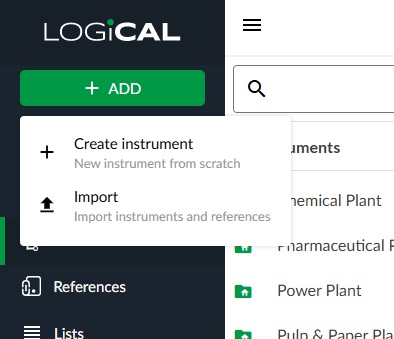Overview
The LOGiCAL import tool is a quick and easy way to add or edit large numbers of assets in your LOGiCAL organization, saving time, reducing the risk of typing errors and promoting high-quality and harmonized data.
The import tool can be used for following purposes:
- import new instruments from other systems to LOGiCAL
- export your existing instruments from LOGiCAL, review and modify the instrument data in Excel and import the modified data back to LOGiCAL to update existing records.
- import new references to LOGiCAL
This functionality can be used by a user with a permission to use the import tool if role-based access control feature is active in the organization.
Import view

To open the Import tool, click on the + Add on the navigation pane and select "Import" from the menu. Both instruments and references can be imported via the same view.
New import
Instruments and references are imported to LOGiCAL using Excel spreadsheets (.xlsx, .xls) or JSON files (.json). The import file can be prepared using the import templates or by exporting existing instruments via the instruments view. All templates are available in one zip file that can be downloaded by clicking the Templates button.
The available import templates with use cases are presented in the table below.
| Import template | Used to |
|---|---|
| templateXmtr.xlsx | import new instruments (other than switches). |
| templateChecklist.xlsx | Import new checklist instruments |
| templateSwitch.xlsx | import new switch instruments |
| templateReference.xlsx | import new references |
| templateXmtr.json | import new instruments (other than switches). |
| templateChecklist.json | Import new checklist instruments |
| templateSwitch.json | import new switch instruments |
| templateReference.json | import new references |
All Excel import templates contain two tabs:
- Sheet 1: This tab is where you fill out the data to be imported.
- Examples: This tab contains some example items.
Fill in or edit the data
Open the file to be imported in Microsoft Excel or any other program capable of editing .xls, .xlsx or .json files.
If importing new instruments or references, Instrument import and Reference import pages instruct you on the specific data fields to fill. You can also copy an example item and modify the necessary fields.
If editing existing instruments, make the necessary modifications in the exported data and save the file.
Close the file in Excel before starting the import in LOGiCAL.
Note!
You should save the import file with a recognizable name, as it will be shown in the import log view (“In progress” tab).
When modifying exported data, it's recommended to retain the original export file as a backup and save the modified file under a different name.
Import data
You can drag and drop the file to the import area, or click the area to browse for the file.
Once the file is chosen, LOGiCAL validates the data and shows a preview of the data to be imported:
- Excel row
- Status of the validation
- Instrument and function identifications and
- Validation note indicates if there is an error found during data validation.
Import can be started by clicking START IMPORT. Importing will take some time so be patient.
In case of error during import please review your files and try again.
Note!
Data rows that have validation errors cannot be imported.
If an issue occurs while editing existing instruments through an import, you can revert the instrument database by re-importing the original export file.
In progress
This view shows imports that are in progress. By clicking on the data row, you can see more details.
Import history
This view lists all import events, indicating
- the name of the imported file
- the type of the instrument template
- Status of the import (e.g. Completed or Failed)
- Timestamp of the Import start time and
- Who started the import process
By clicking on the data row, you can see more details.
Export data
Instruments can be exported by selecting single or multiple rows in the instruments management view. You can even export instruments for whole plants by selecting the plant root.
To export, right-click the row and choose Export from the context menu. The instruments are exported as separate files (.xlsx) depending on type of instrument e.g. switch, xmtr.
The files can later be modified and re-imported to LOGiCAL if needed.